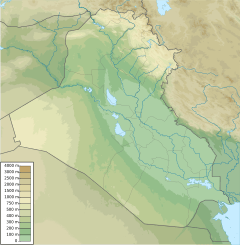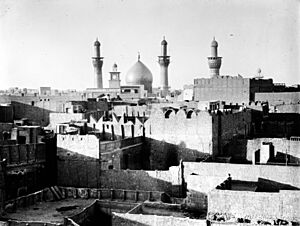Karbala facts for kids
Quick facts for kids
Karbala
كَرْبَلَاء
|
|
|---|---|
| Mayoralty of Karbala | |
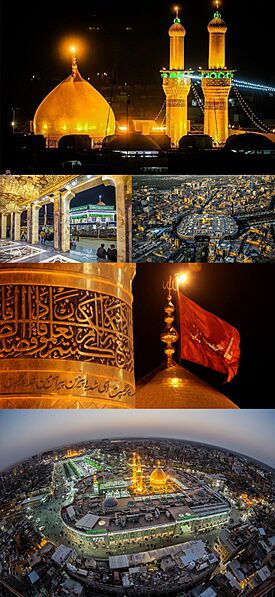 |
|
| Country | |
| Governorate | Karbala |
| Settled | 690 CE |
| Government | |
| • Type | Mayor–council |
| Area | |
| • Total | 42.4 km2 (16.4 sq mi) |
| Elevation | 28 m (92 ft) |
| Population | |
| • Estimate
(2018)
|
711,530 |
| Demonym(s) | Karbalaei |
| Time zone | UTC+3 (Arabian Standard Time) |
| • Summer (DST) | UTC+3 (No DST) |
| Postal code |
10001 to 10090
|
Karbala (also spelled Kerbala) is a city in central Iraq. It is about 100 kilometers (62 miles) southwest of Baghdad. The city is the capital of the Karbala Governorate. In 2024, its population was estimated to be around 691,100 people.
Karbala is famous for the Battle of Karbala in 680 AD. It is also known for the shrines of Husayn and Abbas. These are very important holy sites for Shia Muslims. Millions of Shia Muslims visit Karbala every year. They come to remember the martyrdom of Husayn ibn 'Ali and Abbas ibn 'Ali.
Many pilgrims visit the city for ʿĀshūrāʾ. This is the tenth day of Muharram, marking Husayn's death. Even more people visit for Arbaʿeen, which is 40 days after Ashura. Up to 40 million people visit the graves then. Most pilgrims walk from all over Iraq and more than 56 other countries.
Contents
What's in a Name? The Meaning of Karbala
People have different ideas about where the name Karbala comes from. Some think it's linked to an old language called "Karbalato." Others believe it comes from ancient Babylonian villages. These villages included Nainawa, Al-Ghadiriyya, Karbella (or Karb Illu), Al-Nawaweess, and Al-Heer. Today, Al-Heer is known as Al-Hair, where Husayn ibn Ali's grave is.
The explorer Yaqut al-Hamawi suggested that Karbala might mean "soft earth." This describes the ground where Husayn ibn Ali was martyred.
Shia Muslims believe the archangel Gabriel told Muhammad the true meaning. He said Karbala combines two Arabic words:
- Karb (Arabic: كَرْب), meaning "the land which will cause many agonies."
- Balāʾ (Arabic: بَلاء), meaning "afflictions."
Karbala's Past: A Look at History
The Battle of Karbala: A Key Event
The Battle of Karbala happened on October 10, 680 AD. It took place in the deserts on the way to Kufa. Husayn ibn Ali and his brother Abbas ibn Ali were buried there. This site later became known as the Mashhad Al-Husayn.
The battle started because Husayn refused to pledge loyalty to Yazid. Yazid's governor, Ubaydallah ibn Ziyad, sent 30,000 horsemen against Husayn. Husayn was traveling with his family and a few friends. There were only about 73 men with him, including his six-month-old son, Ali Asghar.
The horsemen were ordered to cut off Husayn's group from water. They wanted to force Husayn to surrender. On the 9th of Muharram, Husayn refused. He asked for one night to pray. On the 10th day, Husayn and his followers fought. Many of them, including his sons and nephews, were killed.
After the battle, Yazid released Husayn's surviving family members. They stopped at the battle site on their way to Mecca. People began to visit the site as early as 685 AD. The city of Karbala grew around Husayn ibn Ali's tomb and shrine. It developed to serve the needs of pilgrims.
Over time, Muslim rulers expanded the city and tombs. However, attacking armies often damaged them. The first shrine was destroyed in 850 AD but rebuilt around 979 AD. It was partly destroyed by fire in 1086 but rebuilt again.
Modern History of Karbala
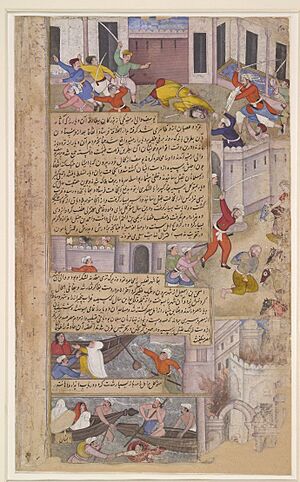
Like the city of Najaf, Karbala faced water shortages for a long time. This problem was fixed in the early 1700s by building a dam. In 1737, Karbala became the main center for Shia Islamic studies. It took over from Isfahan in Iran.
In 1802, about 12,000 Wahhabi Muslims attacked Karbala. This attack happened during a religious anniversary. Between 3,000 and 5,000 people died. The dome of Husayn's tomb was also destroyed. The fight lasted for eight hours.
After this attack, Karbala had some freedom under Ottoman rule. It was managed by local groups. To regain control, the Ottoman army attacked the city in 1843. About 3,000 Arabs were killed inside the city. Another 2,000 died outside its walls. This made many students and scholars move to Najaf. Najaf then became the main Shia religious center.
Between 1850 and 1903, Karbala received a lot of money. This came from the "Oudh Bequest." It was money from an Indian province called Awadh. This money helped the holy cities of Karbala and Najaf.
In 1915, there was an uprising in Karbala against the Ottoman Empire. In 1928, a big drainage project helped clear unhealthy swamps in the city.
In 2004, there were fights in Karbala. Iraqi rebels tried to take over the city hall. Polish and Bulgarian soldiers defended it. In 2003, after the American invasion, the Karbala city council tried to make a US Marine officer their mayor.
On April 14, 2007, a car bomb exploded near Husayn's shrine. It killed 47 people and injured over 150. On January 19, 2008, two million Iraqi Shia pilgrims marched through Karbala. They were there to celebrate Ashura. Iraqi troops and police guarded the event.
Karbala's Climate
Karbala has a hot desert climate. This means it has very hot, long, and dry summers. The winters are mild. Most of the rain falls between November and April. However, no month gets a lot of rain.
| Climate data for Karbala (1991-2020) | |||||||||||||
|---|---|---|---|---|---|---|---|---|---|---|---|---|---|
| Month | Jan | Feb | Mar | Apr | May | Jun | Jul | Aug | Sep | Oct | Nov | Dec | Year |
| Mean daily maximum °C (°F) | 16.6 (61.9) |
19.5 (67.1) |
24.6 (76.3) |
31.3 (88.3) |
37.6 (99.7) |
42.4 (108.3) |
44.7 (112.5) |
44.7 (112.5) |
40.9 (105.6) |
34.2 (93.6) |
24.1 (75.4) |
18.3 (64.9) |
31.6 (88.8) |
| Daily mean °C (°F) | 10.6 (51.1) |
12.9 (55.2) |
17.4 (63.3) |
23.9 (75.0) |
29.7 (85.5) |
33.9 (93.0) |
36.4 (97.5) |
35.9 (96.6) |
32.3 (90.1) |
26.2 (79.2) |
17.7 (63.9) |
12.3 (54.1) |
24.1 (75.4) |
| Mean daily minimum °C (°F) | 6.0 (42.8) |
8.0 (46.4) |
12.1 (53.8) |
17.9 (64.2) |
23.5 (74.3) |
27.6 (81.7) |
29.8 (85.6) |
29.3 (84.7) |
25.6 (78.1) |
20.1 (68.2) |
12.1 (53.8) |
7.4 (45.3) |
18.3 (64.9) |
| Average precipitation mm (inches) | 17.6 (0.69) |
14.5 (0.57) |
14.1 (0.56) |
11.9 (0.47) |
2.4 (0.09) |
0.0 (0.0) |
0.0 (0.0) |
0.0 (0.0) |
0.3 (0.01) |
4.1 (0.16) |
14.8 (0.58) |
13.8 (0.54) |
93.5 (3.67) |
| Average precipitation days | 7 | 5 | 6 | 5 | 3 | 0 | 0 | 0 | 0 | 4 | 5 | 7 | 42 |
| Average relative humidity (%) | 72.1 | 60.7 | 49.8 | 42.5 | 34.1 | 28.2 | 28.6 | 30.2 | 34.9 | 44.7 | 61.5 | 70.5 | 46.5 |
| Source: World Meteorological Organisation (precipitation days 1976-2008) | |||||||||||||
Karbala's Religious Importance
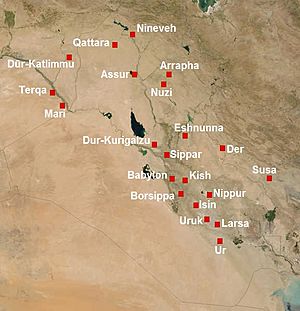
For Shia Muslims, Karbala is one of the holiest places on Earth. This is because of its connection to Husayn ibn Ali and other important figures.
What the Quran Says
Some Shia Muslims believe a verse in the Quran refers to Iraq. This land is home to many Shia holy sites like Karbala. The verse talks about Ibrāhīm (Abraham) and Lūṭ (Lot). They are seen as prophets and are believed to have lived in ancient Iraq.
Then We delivered him(Ibrahim), along with Lot, to the land We had showered with blessings for all people.
The Quran also mentions places like Mount Judi, Babil (Babylon), and Qaryat Yunus (Town of Jonah). These are all part of the ancient region of Mesopotamia, where Karbala is located.
Sayings and Traditions (Hadith)
Many Shia traditions talk about how special Karbala is:
Karbala, where your grandson and his family will be martyred, is one of the most blessed and the most sacred lands on Earth, and it is one of the valleys of Paradise.
- The fourth Shi'ite Imam, Zayn al-Abidin, said:
God chose the land of Karbalā' as a safe and blessed sanctuary twenty-four thousand years before He created the land of the Ka'bah and chose it as a sanctuary. Verily it (Karbala) will shine among the gardens of Paradise like a shining star shines among the stars for the people of Earth.
- Ja'far al-Sadiq said: "Not one night passes in which Gabriel and Michael do not go to visit him [Husayn]."
- Ja'far also said that the dust from Imam Husayn's grave is a cure for sickness and protection from fear.
Culture and Life in Karbala
Religious Tourism: A Major Draw
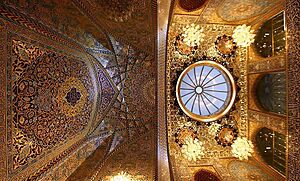
Karbala is a very popular place for Shia Muslims to visit. Tourism has grown a lot since the end of Saddam Hussein's rule. Important religious sites include:
- Al Abbas Mosque
- Imam Husayn Shrine
- The Euphrates River
- The Ruins of Mujada, about 40 kilometers (25 miles) west of the city.
The Arbaeen pilgrimage is a huge yearly event in Karbala. It is one of the largest peaceful gatherings in the world. In 2017, about 30 million people took part in this pilgrimage.
Sports in Karbala
Karbala FC is the city's football club. They play in the Iraq Stars League, which is the top football league in Iraq.
The Karbala Sports City is a large sports complex south of the city. It has the Karbala International Stadium, which can hold 30,000 people. There's also a smaller football stadium, a training field, a swimming hall, and a hotel.
Karbala's Influence in Other Cultures
In the Indian subcontinent, "Karbala" can mean two things. It refers to the city itself, often called Karbala-e-Mualla (meaning "Karbala the exalted"). It also refers to local grounds where special processions end. These grounds often have copies of the Rauza (Husayn's tomb) or other structures.
This tradition started because India was far from Karbala. It was hard for Indian Shia Muslims to visit Husayn's tomb or be buried near it. So, they created local "karbalas" by bringing soil from the real Karbala. They sprinkled this soil on areas meant for future cemeteries.
Then, they built small models of Husayn's tomb, called ta'zīya. These models are carried in processions during Muharram. Thousands of ta'zīyas are made each year. They are carried in parades and sometimes buried at the end of Ashura or Arba'een.
Learning and Education
Universities in Karbala
Karbala is home to several universities:
- University of Karbala: Opened in 2002, it is known for its academic management and research.
- Ahl al-Bayt University: Founded in 2003, it has colleges like Law, Arts, Islamic Sciences, and Dentistry.
- Warith al-Anbiya University: Started in 2017, it is sponsored by the Imam Husayn Holy Shrine. It offers studies in engineering, economics, law, and pathology.
Hawza Seminary: Islamic Education
The Hawza are Islamic education centers. They are guided by religious scholars. They teach Shia Muslims to become religious scholars themselves. Karbala's Hawza used to have many Iranian and Turkish scholars.
However, after some events in the 1800s, many scholars moved to Najaf. This made Najaf the main center for Shia Islamic education. Today, the Hawza Seminary still exists in Karbala, but it is smaller compared to Najaf.
City Infrastructure
Airports Serving Karbala
Karbala has two airports:
- Karbala Northeast Airport
- Karbala International Airport (located southeast of the city)
High-Speed Railway Project
In February 2024, Iraq announced plans for a new high-speed railway. It will connect Karbala and Najaf. Once finished, it will be able to carry up to 25,000 passengers every hour.
Karbala's Global Connections
Sister Cities Around the World
As of 2024, Karbala has four sister cities. These are cities that have special friendly relationships:
Images for kids
 In Spanish: Kerbala para niños
In Spanish: Kerbala para niños


